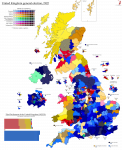The Coalition, which by now consisted only of the Unionists and the half of the Liberal Party who still followed Lloyd George, spluttered on for another three and a half years. It fell apart because, well, there was very little left for it to agree on after the peace was secured. Lloyd George wanted to use the massive mandate given to the Coalition in 1918 to enact sweeping social reforms, to which his coalition partners said "um, what part of '
Conservative and Unionist Party' do you not understand". It was really sort of astonishing in light of this that it went on as long as it did, and its collapse only came about after it was revealed that Lloyd George had used his position as Prime Minister to sell baronetcies and knighthoods to Liberal donors.
The cash for honours scandal combined with the Chanak Crisis, where Lloyd George nearly provoked war with Turkey against the will of the war-weary armed forces, to force an election in autumn 1922. Unionist leader Austen Chamberlain was still cautiously willing to campaign as a Coalition, planning a joint speaking tour with Lloyd George, but on the 19th of October a meeting of Unionist MPs at the party-affiliated Carlton Club in London voted against continuing the Coalition by a three-quarters majority. Chamberlain resigned and was replaced by Andrew Bonar Law, the previous Unionist leader in the House of Commons, who had led internal opposition to the Coalition within the Unionist Party. The Unionist backbenches, newly empowered, formed a committee to discuss political matters independently of the party leadership, and over time this morphed into the '1922 Committee', the modern Conservative Party parliamentary group.
With the breakdown of the Coalition, a unified Unionist Party went to the country under Bonar Law's leadership seeking a mandate for a single-party majority. However, Lloyd George still held out hope for a new Coalition, and took about half the Liberal parliamentary party with him into a new "National Liberal" organisation. The National Liberals (not to be confused with the 1930s-50s party of the same name) campaigned on carrying on the Coalition, even though it was patently obvious that this wasn't going to happen. They still won about fifty seats, nearly as many as the main Liberal Party (theoretically led by a very tired and irrelevant H. H. Asquith) - largely because the two parties only stood against one another in about thirty constituencies.
In general, the culture of "everyone stands everywhere" was a lot less developed in 1922, and most seats were two-way contests between any two of the three major parties. There were a few places where the Liberal vote split allowing Labour to squeak through the middle, and in general, Labour had a very good election. They won 142 seats on just under thirty percent of the vote (about the same as the two Liberal factions combined), and formed the official opposition for the first time. J. R. Clynes, who led the party into the election, was replaced as party leader in the House by Ramsay MacDonald, who'd been out of favour up until this point because he opposed the war. Within eighteen months, MacDonald would be Prime Minister.
Oh, and the Irish thing happened. In 1920, the Irish Government Act had divided the island into Northern Ireland and Southern Ireland. The idea was for these to be temporary units, with an all-Ireland cooperation body called the Council of Ireland set up to facilitate cooperation and eventual merger into a united home-rule Ireland. But by this point there had been all-out war between Irish Catholics and the Crown for a couple of years, and neither side was too keen on trusting the other side with any sort of authority over them. So, the Anglo-Irish Treaty, which came into effect in March 1922, allowed Southern Ireland to go its own way and become the Irish Free State, while Northern Ireland opted out of the Free State and carried on as an autonomous part of the UK. Confused yet? Well, it doesn't quite stop there, because Northern Ireland also had its parliamentary representation reduced, and for some reason, decided to go back to 1868-1885-style constituencies. Solidly Protestant counties Antrim, Down, (London)derry and Armagh became constituencies of their own, while the more marginal Tyrone and Fermanagh became one single massive two-seat constituency. Belfast, meanwhile, was brought back to its old four-seat division. All these seats were unopposed in 1922 except Derry, which was won by the Unionists on a huge margin, and Tyrone-Fermanagh, which was narrowly carried by the husk of the IPP. The Irish Nationalists also held Liverpool Scotland, an overwhelmingly Irish Catholic part of the city.


